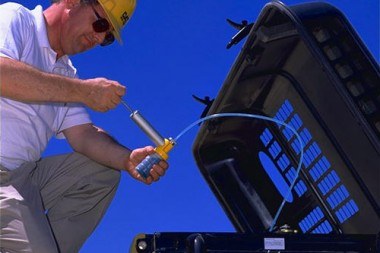Tips For Taking An Oil Sample
Take Samples from the New Oil Source
Whether you store your oil in drums or bulk storage, take samples from the source to confirm your oil storage practices are not contaminating the oil. These samples are also used as the reference for oil condition comparison.
Keep Sampling Supplies Clean
Dirty supplies will contaminate your samples and cause inaccurate test results. Keep new sample bottles capped and store them in dust-free plastic bags. Be sure your vacuum pump, tubing and valve probes are protected from dust during storage.
Use a Tube Cutter for Oil Sample Tubing
Using the Tube Cutter (1U7648) is better than a pocket knife. It gives you a clean cut while using only one hand and is less likely to transfer contamination. Replacement blades (1U8589) are also available.
Inspect the Filters
You can get valuable information about your equipment by cutting open used filters. The 4C5084 Filter Cutting Tool may be purchased for this purpose. If metal particles are present, a magnet can be used to determine if they are iron or steel. Also be alert for pieces of synthetic friction material or rubber seals which may indicate a problem.
Avoid Contamination
To avoid contamination, do not take samples from the drain stream, a waste oil container, or a used filter. The sampling gun/tubing and sampling valve methods are the preferred sampling techniques.
Use Protective Dust Caps
Rubber dust caps should be kept on all sampling valves. These black rubber caps indicate the system being sampled and help protect the valve from contamination that could taint test results. If a dust cap is missing, promptly order the appropriate replacement.
- 8C3445 Dust Cap (Engine)
- 8C3447 Dust Cap (Transmission)
- 8C345 1 Dust Cap (Hydraulic)
- 157-0670 Dust Cap (Engine Coolant)
- 6V0852 Dust Cap (Blank)
- 8C8456 Seal Cap (Stops leaks)
Provide Complete Sample Information Labels
It is impossible for an interpreter to give accurate recommendations without all the required information on the sampling card. Fill out as much information as possible before you begin taking samples, and then add the meter reading when you get to the machine or engine. You’ll find your cards are more legible and the job will take less time. Model, serial number, and service meter units on both equipment and oil are very important. For optimal results, record the hours or miles on the oil and the amount of make-up oil added since the last oil change. It is also critical to indicate whether or not you changed the oil when you took the sample.
Submit Your Sample(s) Promptly
Send your sample to the lab immediately. Test results predicting failure are no good if they get to you too late.

